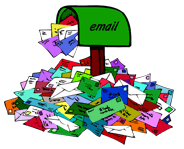

3 X Per Week Produces 40% More Revenue Per Month, But 40% Less Per Email
There have been various studies to prove that increasing email sending frequency is a double edged sword. When mailings are increased from weekly to three times a week, the increased campaign produces approximately 40% more revenue per month. However, the average revenue produced per email sent drops by 40%… and there’s more bad news.
The higher frequency’s unsubscribe rate is 140% greater than that of the lower frequency one. Therefore, if you’re averaging a 1% unsubscribe on a weekly frequency, you can look forward to a 2.4% unsubscribe rate at the higher frequency. The spam complaint rate per emailing increases by 600%, and over a full month, the increase is 1,300%. Therefore you can expect your overall spam complaints per month to vary from 0.05% at the low frequency to an uncomfortable 0.65% at the high frequency.
High Frequency Email Sends Can Cost You More Than 1/3 of Your List Per Year
Without even factoring in the increase in the hard bounce rate, the unsubscribes plus the spam complaints alone will cost you 3.05% of your list every month, or 36.6% a year. That’s more than a third of your subscribers gone, and with a bad taste in their mouths as well. In less than three years, there might not be a single original name left from your list today!
Plugging in some financial factors brings the abstract percentages into a better perspective. Let’s assume that your weekly emailing is producing $2 million in revenue a year from a list of 500,000 prospects. Jumping to a thrice weekly format will increase that to $2.8 million. That seems great until you consider that you’ll be losing 183,000 of those customers per year, and if you calculate an average cost of $12 for replacing each of those losses with prospects of roughly equal value, keeping your list numbers consistent will cost nearly $2.2 million. There are also considerable additional costs to creating, testing and sending the millions of extra emails.
When Seeking to Increase Your Strategy’s Effectiveness, Ask Yourself These Questions
Of course very few email marketers engage in campaigns of this frequency, but the numbers do show that simply ramping up the frequency of your emails is not the wisest strategy. Therefore you should consider the other aspects of your email strategy to maximize its effectiveness by asking yourself these important basic questions:
- Do you have an email messaging strategy and is it effective?
- Can the success metrics of your brand be improved?
- What is your customer acquisition vs. loss rate?
- What is your customer acquisition cost?
- Are your customers more or less responsive to you than they were last year at this time?
- Are your customers spending more or less with you than they were last year at this time?
- Is your product or service facing competition of a type that did not exist a year ago?
And most importantly…
This analysis will help you determine the basic current status of your overall email campaigns and branding efforts so that you can determine if your success (or lack thereof) can be attributed to your email marketing policies. There are many aspects to consider when you are analyzing your campaign strategies, and simply cranking up the frequency of your emails is not necessarily the best option.




